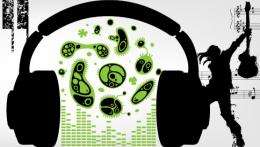Sonification of microbial data

(Medical Xpress)—Soft horns and a tinkling piano form the backbone of "Fifty Degrees North, Four Degrees West," a jazz number with two interesting twists: it has no composer and no actual musicians. Unless you count bacteria and other tiny microbes, that is.
The song is the brainchild of Peter Larsen, a biologist at the U.S. Department of Energy's Argonne National Laboratory. Larsen, it turns out, has no musical training at all; his interests run less towards the blues and more towards blue-green algae.
When faced with an avalanche of microbial data collected from samples taken from the western English Channel, Larsen recognized he needed a way to make sense of it all. "Thinking of interesting ways to highlight interactions within data is part of my daily job," he said. "I am always trying to find new ways to visualize those relationships in ways so that someone can make relevant biological conclusions."
In the case of the western English Channel data, however, Larsen decided that a visual representation of the data would not be as effective as one he could hear.
"There are certain parameters like sunlight, temperature or the concentration of phosphorus in the water that give a kind of structure to the data and determine the microbial populations," he said. "This structure provides us with an intuitive way to use music to describe a wide range of natural phenomena."
A colleague of Larsen's suggested that classical music could effectively represent the data, but Larsen wanted any patterns inherent in the information to emerge naturally and not to be imposed from without.
"For something as structured as classical music, there's an insufficient amount of structure that you can infer without having to tweak the result to fit what you perceive it should sound like," Larsen said. "We didn't want to do that."
While this is not the first attempt to "sonify" data, it is one of the more mellifluous examples of the genre. "We were astounded by just how musical it sounded," Larsen said. "A large majority of attempts to converting linear data into sound succeed, but they really don't obey the dictates of music – meter, tempo, harmony. To see these things in natural phenomena and to describe them was a wonderful surprise."
According to Larsen, the musicality of the data is not limited to the organisms in the English Channel. In another set of analysis, he and his colleagues used a similar methodology to look at the relationship between a plant and a fungus.
"We expect to see the same intuitive patterns recurring in different environments," he said. "Sometimes, it can sound a little avant-garde, but it's not random because it reflects very real phenomena."
More information: Listen to examples of microbial bebop here.
Provided by Argonne National Laboratory


















